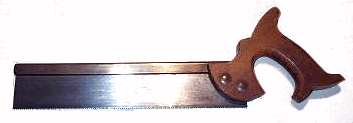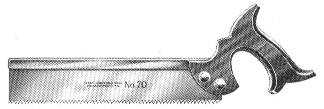| The purpose of a dovetail saw is, as the name implies, to cut dovetails and other fine joints. Besides its small size, the distinguishing feature of the dovetail saw that separates it from other backsaws is the thickness of its blade, about .018" (26 gauge). Other backsaws can be about .025"-.040", depending on length and intended purpose. Miterbox saws are the thickest. A thin blade and its resulting kerf allows the most accurate saw cut for a small joint like a drawer's dovetail. | |


|
Disston made three saws for dovetails and similar fine work. The backs were steel with brass plating. The No. 68 had a straight, turned handle, and is sometimes called a gent's saw today. The No. 70 had an open handle and looked like an English dovetail saw. It did not have the quality of material or finish of a No. 4 backsaw. The No. 70 is not often found today, so must not have been a popular item. No. 68 saws were offered for a longer time and are relatively easy to find.
|
|
The No. 71 was similar to the No. 68, but the handle was offset from the blade in order to allow the user to cut flush with a panel (cutting the extra length from the end of a dowel joint, for example). Saws close in design to the Nos. 68 and 71 still are being sold by other manufacturers today. | |
|
In the 1937 catalog, the No. 68 was available in lengths of 6, 8, 10, and 12 inches. The No. 70 was available 8" or 10", and the No. 71 was 10". In 1918, all the saws were available in 6, 8, 10, and 12" sizes. In addition there was a No. 69 saw, similar to the 68 in appearance, made for cutting non-ferrous metals, such as brass and copper. | |
|
Disston also made a small number of open-handled backsaws other than the No. 70, which were probably meant for dovetail work. The saws are generally six or eight inches in length, but some are up to 12 inches. The blades look like that of a No. 4 backsaw with handles of high quality. They were never listed in any catalog, but several examples exist and were manufactured from the 1840's until the 1890's. An article about these backsaws can be found here. |
|






